Looking toward the future of ecommerce, one thing is clear: evolution is unavoidable. Since 2020, the ecommerce market has seen extrordinary growth. Through 2021 and 2022, the expansion continued, and 2023 presents its own exciting opportunities and unique challenges.
Our new report, “The Future of Ecommerce Is Now: Industry Insights for 2023 & Beyond,” seeks to uncover current ecom trends and offer insights into where the industry is headed.
The report looks specifically at these questions:
- How is industry traffic shifting as we look toward the future?
- How will emerging technologies like artificial intelligence (A.I.) and augmented reality (A.R.) shape the industry?
- How is the industry responding to economic uncertainty?
- How can ecommerce businesses stay competitive in an increasingly crowded landscape?
In this article, we’ll offer a sample of the insights provided in the report. Take a peek, grab your free copy of the full report, and while you’re at it, check out Semrush’s new ecommerce bundles to help you put the insights into action.
Ecommerce Trends in 2023: Will This Year Be the Biggest Yet?
The ecommerce industry has witnessed remarkable growth over the past decade, and this upward trend has continued even in the post-pandemic era. Following the traffic surge of 2020, traffic continued to expand at a slower pace throughout 2021 and 2022, though the average growth remained at an impressive 18% over the three-year period.
As we set our sights on the second half of 2023 and beyond, we see encouraging signs of further growth. Despite a temporary drop in traffic during the summer months of 2022, rates rebounded fully at the beginning of 2023. By the end of 2023’s first quarter, traffic had increased by 8%, surpassing the highs observed throughout 2022 and approaching the all-time industry peak seen in December 2021.
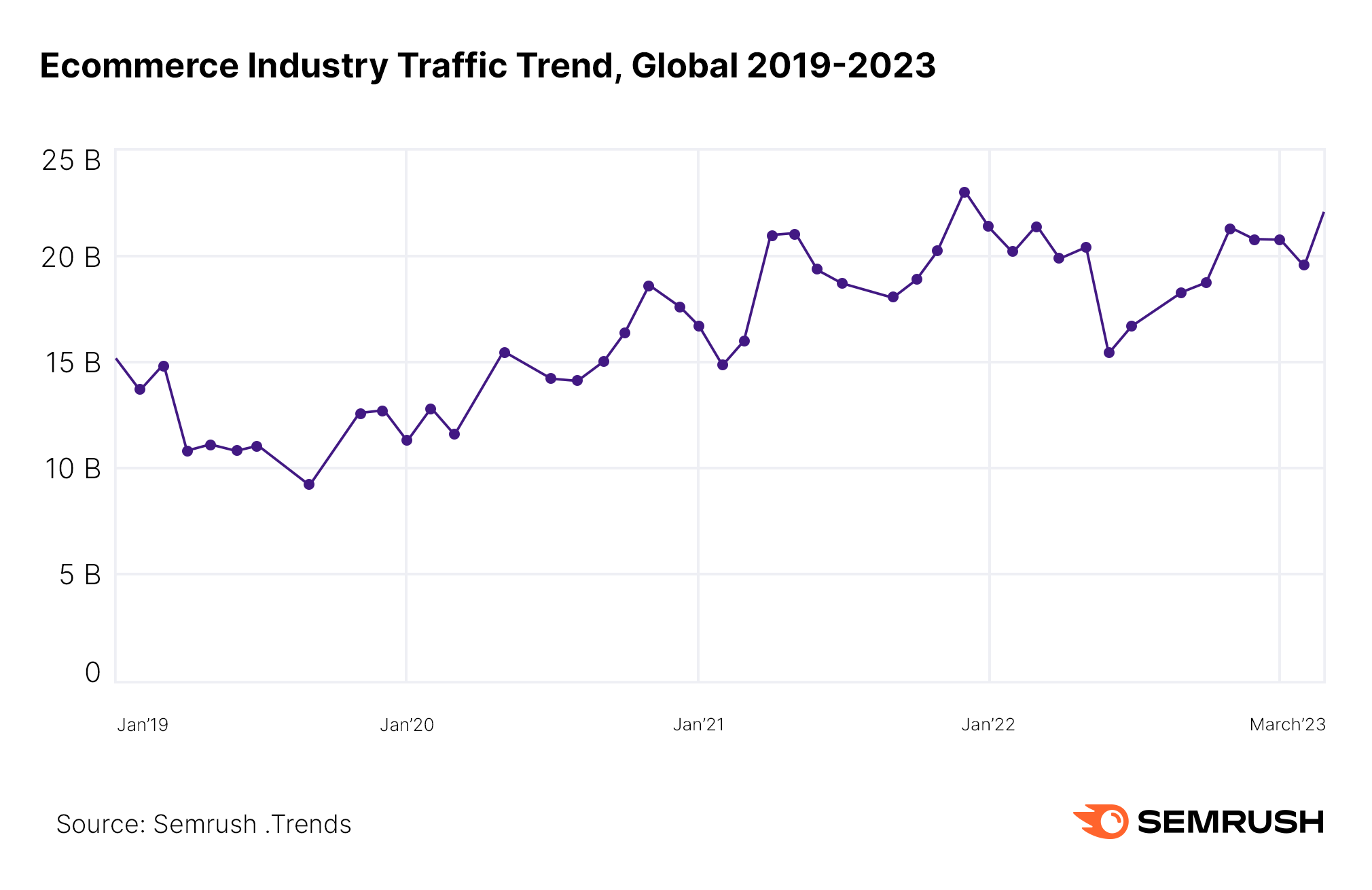
Considering typical seasonal trends in ecommerce, 2023 holds the potential to be another record-breaking year for the ecommerce industry, particularly when taking into account the approaching holiday shopping season.
We also looked at data for 8 key traffic channels available in Semrush’s .Trends solution. Some interesting traffic channel trends emerged for those looking toward the second half of 2023 and beyond.

In early 2023, Direct traffic dominated the ecommerce industry, accounting for over 53% of all traffic. This underscores the importance of brand awareness in marketing strategies for any brand hoping to make their mark online.
The Organic Search and Referral channels have been vying for second and third place, but Organic Search seems to have secured the second spot. Referral traffic experienced a peak of around 15% in 2021 but has since declined. On the other hand, Organic Search surpassed Referral in December 2021 and has consistently maintained its lead, showing signs of growth in 2023.
And while Organic and Paid Social, Paid Search, Email, and Display Ads contribute only a small amount to overall traffic, they shouldn’t be ignored. Notably, Email and Display Ads have experienced a boost in 2023, with Display Ads surpassing 2% and Email crossing the 1% threshold. These shifts may indicate emerging trends in the industry, which could round out a strategy focused on brand awareness, referrals, and search engine optimization.
Look Beyond the U.S. for Your Ecommerce Growth Strategy
The global ecommerce landscape is undergoing significant changes, and businesses must adapt their strategies accordingly. Semrush traffic data reveals a noteworthy shift in web traffic patterns, highlighting the importance of looking beyond the United States for ecommerce growth.
In the past year, the U.S. witnessed a staggering 19% decrease in traffic share, falling from 50% in 2022 to 31% in 2023.
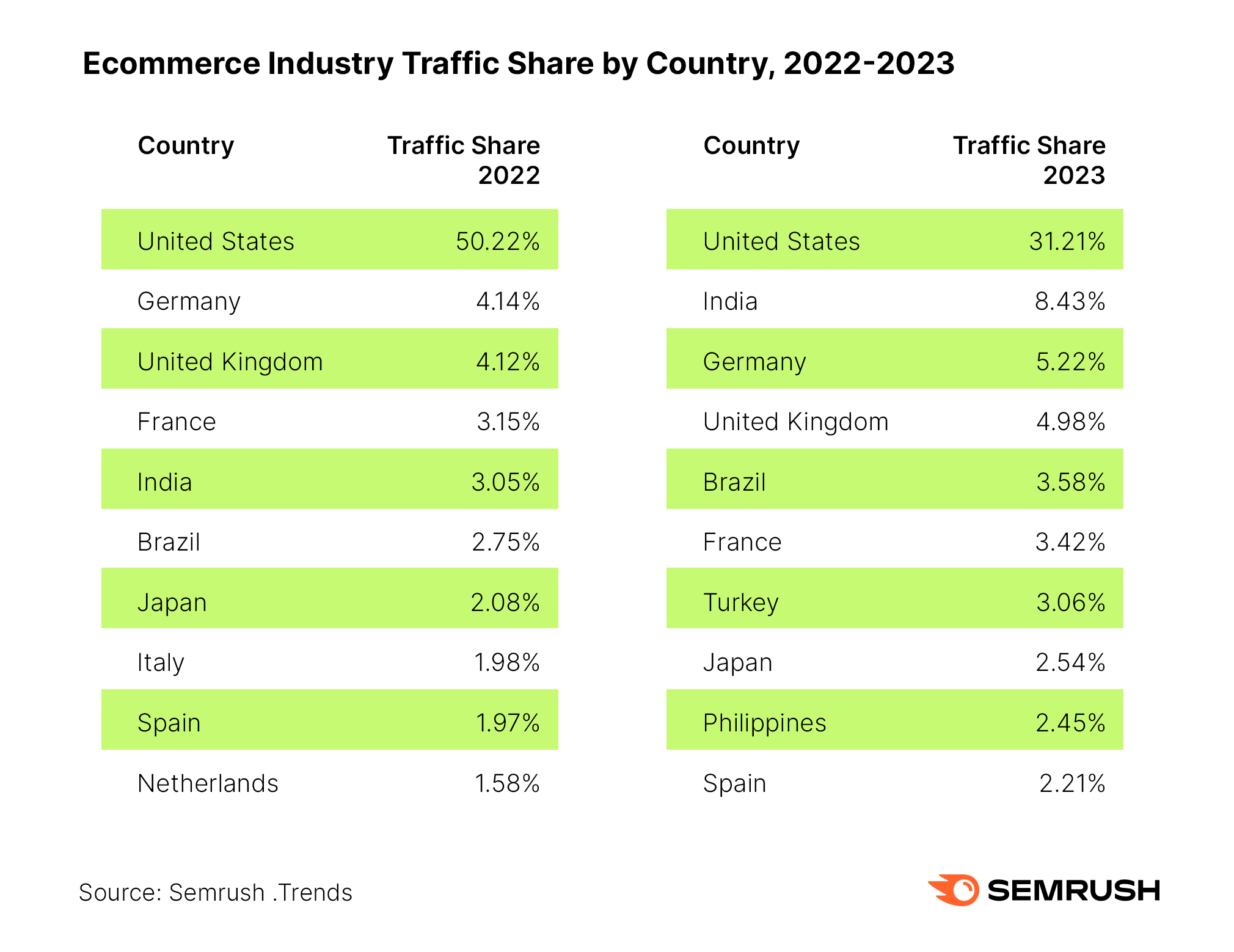
Meanwhile, Asian markets have seen a remarkable surge in traffic. India's share rose from 3% in 2022 to 8.5% in 2023, securing its position as the second-highest country for web traffic. Likewise, The Philippines earned a place on the top 10 list in 2023, capturing 2.5% of the global traffic share.
The Philippines represents one of the fastest growing ecommerce markets globally, revealing an enticing opportunity for expansion and increased revenue.
In contrast, Spain, the Netherlands, and Italy experienced a decline in their web traffic shares in 2023. These European countries lost their spots on the top 10 list, emphasizing the need for businesses to diversify their geographical focus.
Looking to the specific players making the biggest moves globally, we see similar trends.
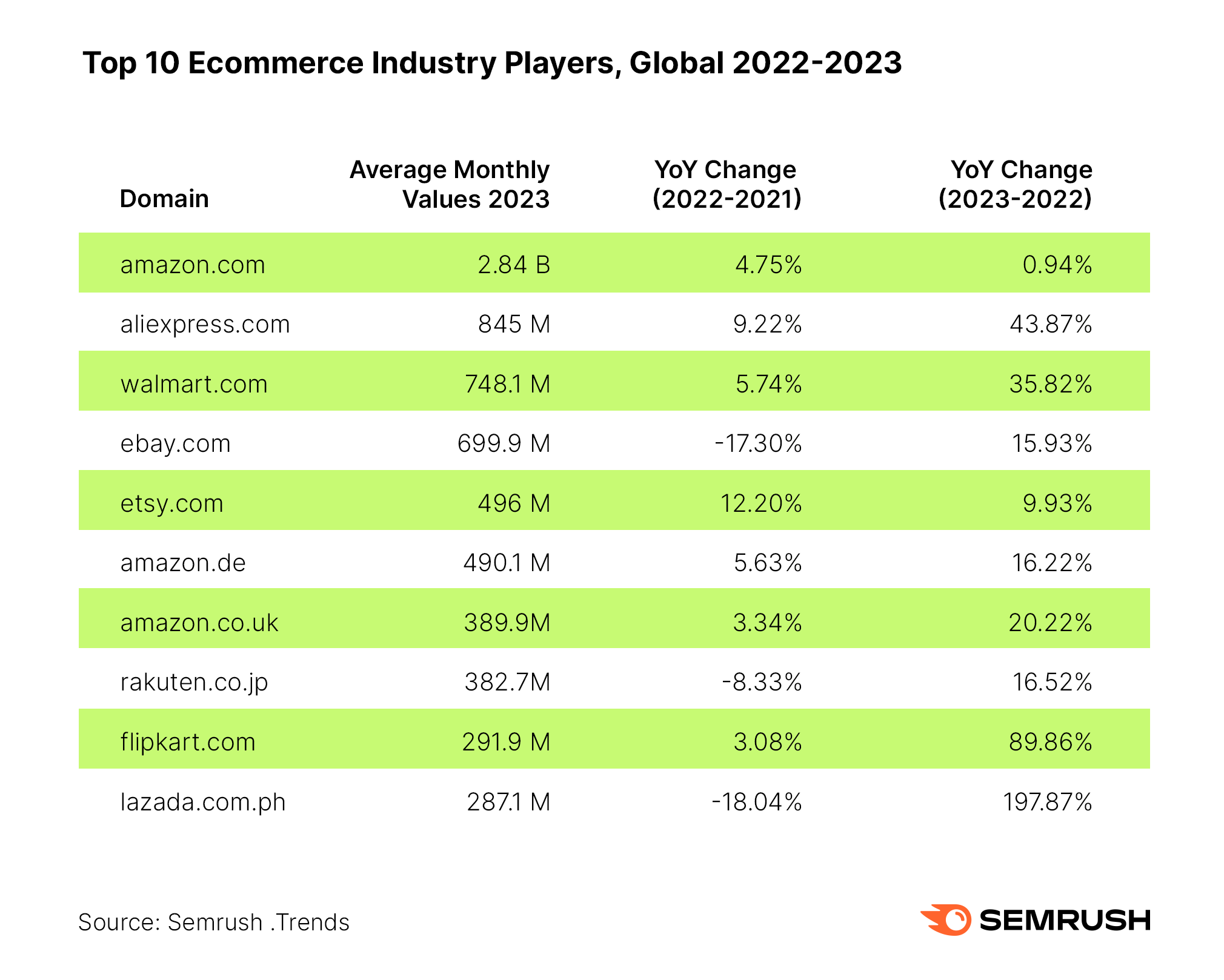
While two of the three top domains in terms of traffic were U.S. companies–amazon.com and walmart.com–the largest year-over-year growth was seen by China-based aliexpress.com with a huge 44% increase.
The leaders in terms of traffic growth were both based in Asian markets. India-based e-tailer flipkart.com saw a significant 90% increase in traffic. The winner, however, was lazada.com.ph, which saw growth near 200% driven by the Philippine market.
As the U.S. and European countries experience a decline in web traffic share, it is crucial for ecommerce businesses to explore opportunities in other regions. India's rapid ascent, the Philippines' promising growth, and the shifting dynamics in European countries all underscore the importance of looking to new markets for a successful ecommerce growth strategy.
Artificial Intelligence: A Growing Revolution in Ecommerce in 2023
Artificial Intelligence (AI) and Augmented Reality (AR) have made a major splash in 2023, and their profound impact on ecommerce is just beginning to become clear. To offer a glimpse of the sudden emergence of AI in the minds of individuals across the glove, take a look at this search data.
Keyword searches for “ChatGPT” went from 10 monthly searches in November 2022 to 101M monthly searches by March 2023.
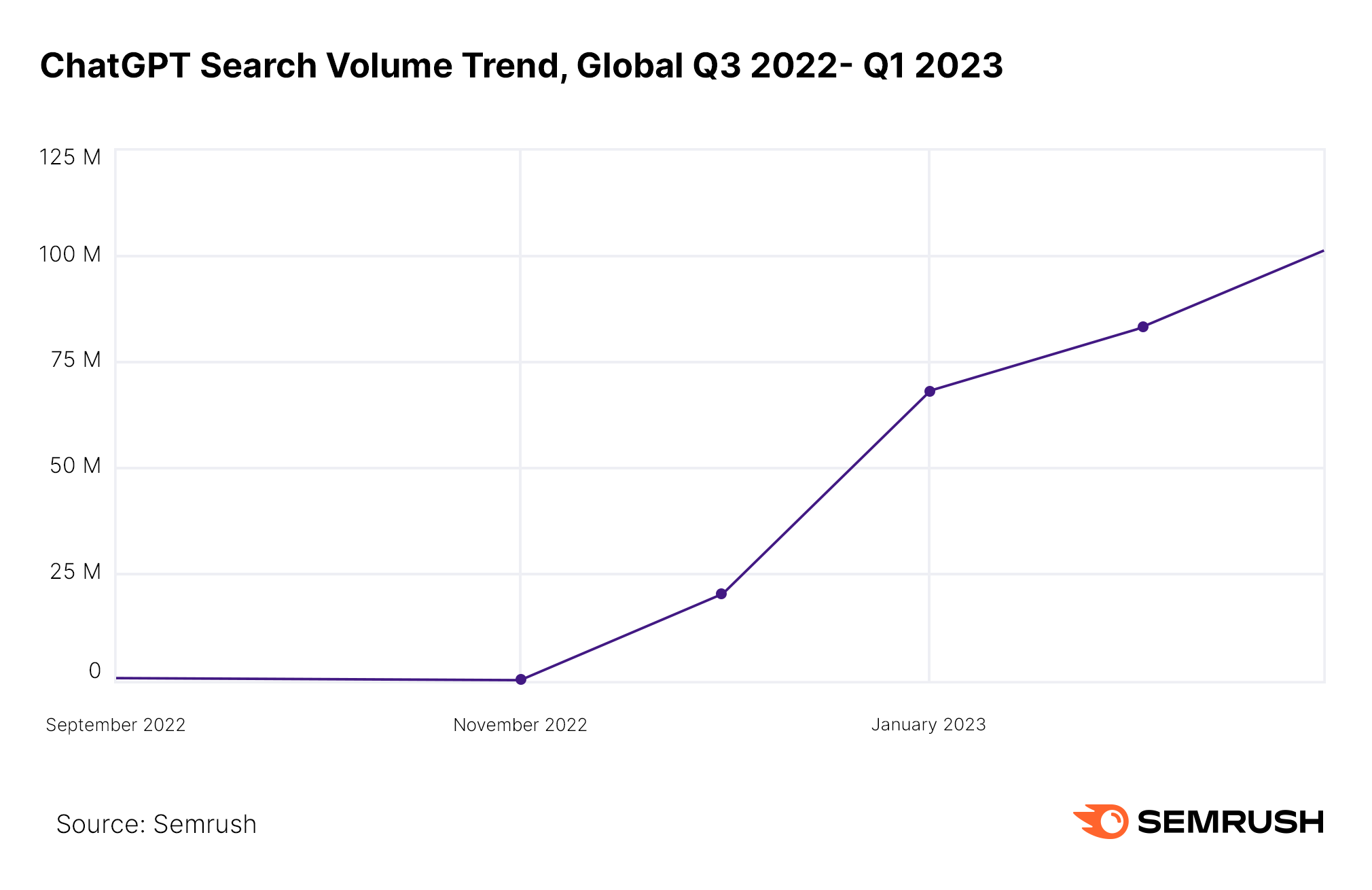
AI and AR are significantly impacting the ecommerce market in 2023 with rapid advancements in language models, computer vision models, and machine learning. These technologies are providing personalized customer experiences, automated customer service, improved ad targeting, and enhanced operations.
Among other things, AI and AR are helping businesses:
- Analyze customer data to provide personalized recommendations for shopper's preferences, optimize for market pricing for shifts, and customize customer experiences
- Stay ahead of challenges with demand and supply chains, ensuring customers' needs are met without burning out employees and wasting resources in the process
- Interpret customer queries, provide relevant responses, and make product recommendations
- Anticipate future customer needs to tailor their marketing strategies and product offerings accordingly
Along similar lines, we discovered some important trends emerging in the realm of ecommerce on social media.
By 2025, the total market value for products sold directly through social media (AKA social selling) is projected to reach a staggering $1.4 trillion. This substantial growth is fueled by various factors, such as the widespread adoption of social media platforms, the impact of influencer marketing, and the surge of mobile commerce.
TikTok in particular has made a major splash in the realm of social selling. Having surpassed 1B users, the video based platform is changing the social media game.
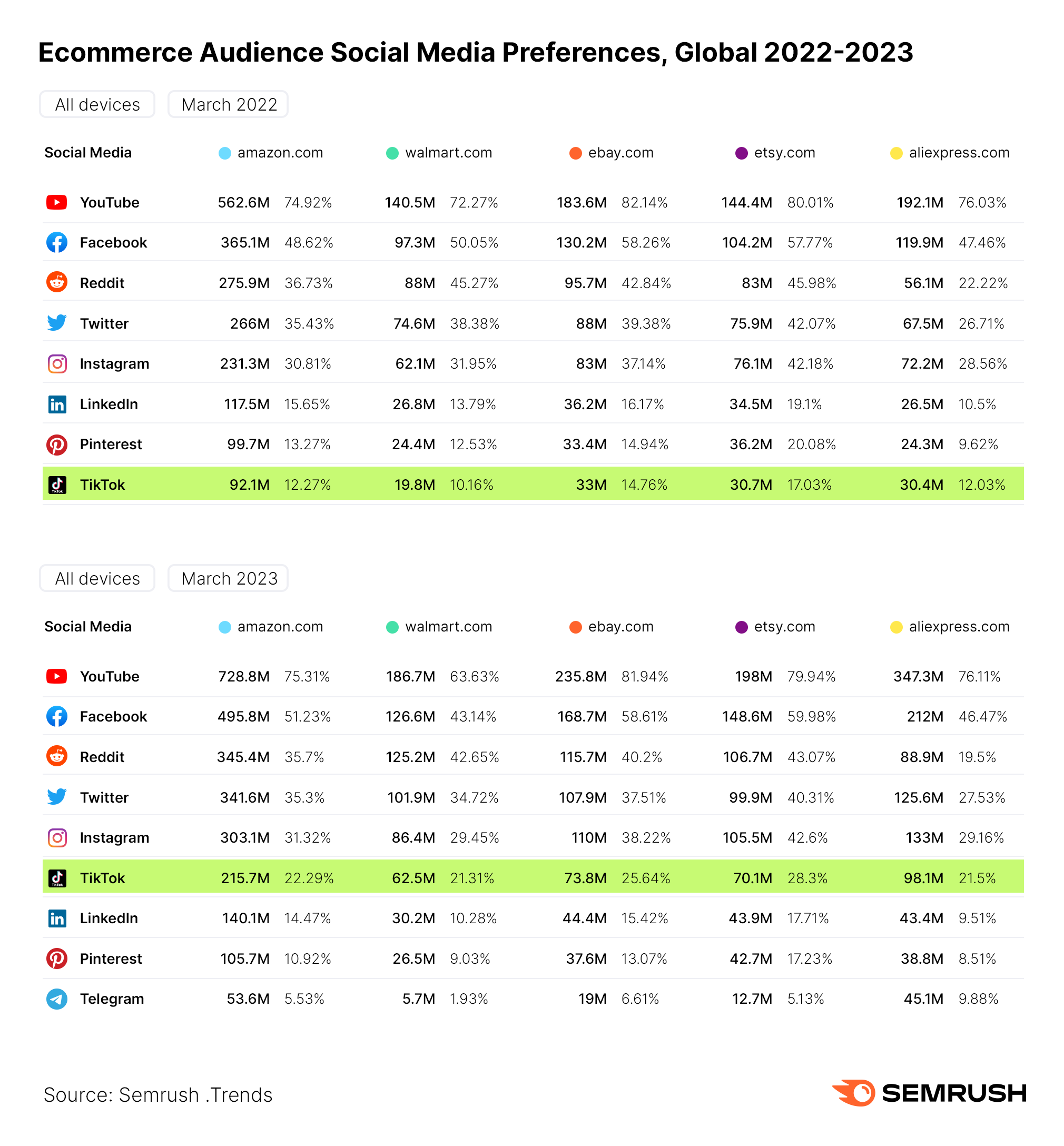
Along with soaring traffic, a growing user base (35% of whom have made a purchase on the platform), and an expanding roster of big-time influencers, TikTok provides unique platform-based tools to effectively reach and convert audiences.
- TikTok storefronts allow sellers to create web stores quickly through simple integrations with ecommerce platforms
- Hashtag and keyword options make it easy to improve visibility to high value audiences
- TikTok can help businesses reach a younger audience, with 63% of Gen Z using the app daily
Overall, businesses that don’t stay up to speed with evolving AI, AR, and social selling technologies are at a significant disadvantage in today's competitive ecommerce landscape. They risk falling behind their competitors, missing out on opportunities for operational efficiency, customer engagement, data-driven insights, and transformative marketing experiences.
Turn Data Into Action: Semrush’s New Ecommerce Bundles
Along with the 2023 Ecommerce Report, Semrush has released two new software bundles designed to help with the unique challenges faced by ecommerce business owners and marketers.
- The Amazon Accelerator Bundle lets you gather Amazon-related competitive intelligence, benchmark against the competition, choose the right keywords, pricing, descriptions, and more
- The Ecommerce .Trends Bundle allows you to optimize your ecommerce strategy across every channel. Gather Amazon insights, conduct market and competitive research, and track trends across the ecommerce market
Each bundle is tailored to help businesses leverage data-driven insights and take decisive action to drive growth and success in the highly competitive online marketplace. Along with your free report, we hope you’ll check out these offers to learn more about how Semrush can help you scale your business and outpace your competitors.
.svg)